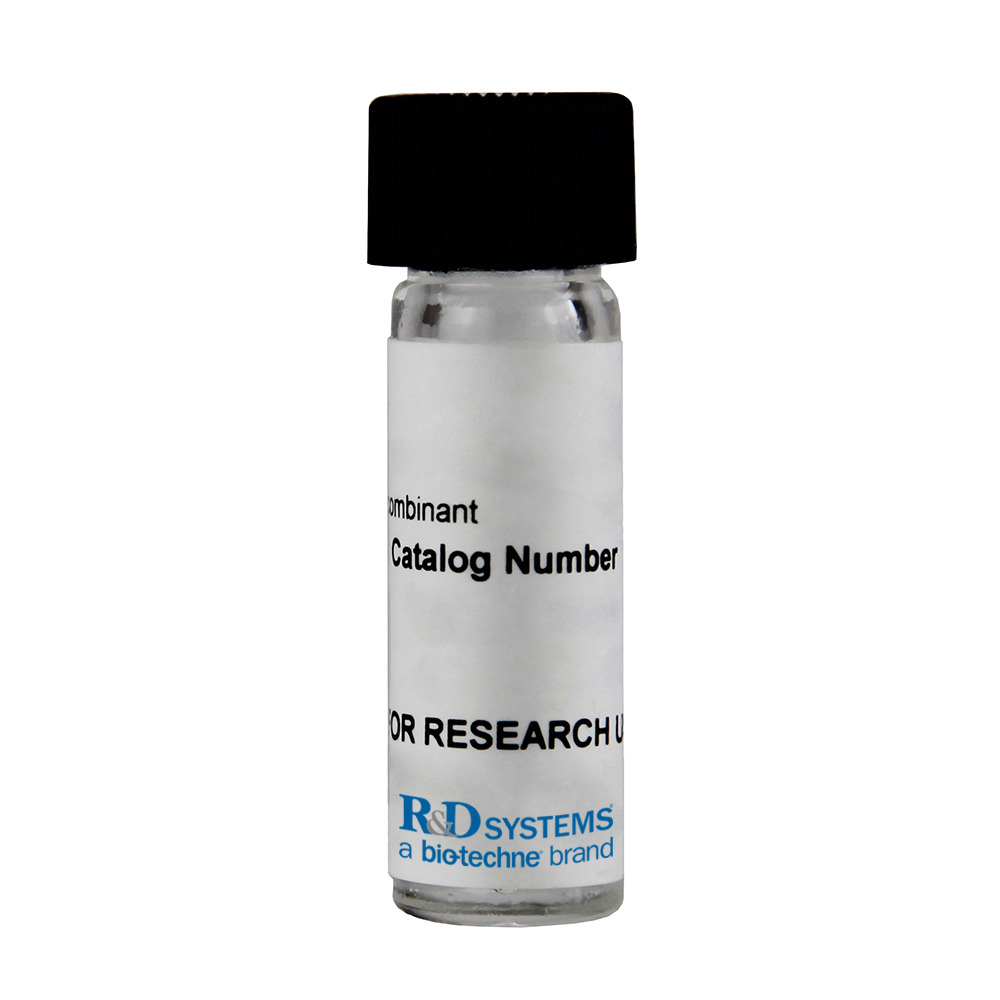 全部商品分类
全部商品分类

 下载产品说明书
下载产品说明书 下载SDS
下载SDS 用小程序,查商品更便捷
用小程序,查商品更便捷


 收藏
收藏
 对比
对比 咨询
咨询Carrier Free
CF stands for Carrier Free (CF). We typically add Bovine Serum Albumin (BSA) as a carrier protein to our recombinant proteins. Adding a carrier protein enhances protein stability, increases shelf-life, and allows the recombinant protein to be stored at a more dilute concentration. The carrier free version does not contain BSA.
In general, we advise purchasing the recombinant protein with BSA for use in cell or tissue culture, or as an ELISA standard. In contrast, the carrier free protein is recommended for applications, in which the presence of BSA could interfere.
7194-IR
| Formulation | Lyophilized from a 0.2 μm filtered solution in PBS. |
| Reconstitution | Reconstitute at 100 μg/mL in PBS. |
| Shipping | The product is shipped at ambient temperature. Upon receipt, store it immediately at the temperature recommended below. |
| Stability & Storage: | Use a manual defrost freezer and avoid repeated freeze-thaw cycles.
|
Recombinant Human IL-15R alpha Fc Chimera (HEK293), CF Summary
Product Specifications
The ED50 for this effect is 2-10 ng/mL.
| Human IL-15 R alpha (Met1-Thr205) Accession # Q13261 | IEGRMD | Human IgG1 (Pro100-Lys330) |
| N-terminus | C-terminus | |
Analysis

Background: IL-15R alpha
Interleukin 15 Receptor alpha (IL‑15 R alpha ), also known as CD215, is a widely expressed 60 kDa transmembrane glycoprotein that plays an important role in the homeostasis and activation of NK cells and CD8+ memory T cells and participates in the development and function of many other hematopoietic cell types and non‑immune cell types (1 ‑ 3). Mature human IL‑15 R alpha consists of a 175 aa extracellular domain (ECD) containing one N‑linked glycosylation site, a 23 aa transmembrane segment, and a 39 aa cytoplasmic tail (4). Within the ECD, human IL‑15 R alpha shares approximately 60% aa sequence identity with mouse and rat IL‑15 R alpha. Alternate splicing of human IL‑15 R alpha generates additional isoforms with variable length deletions in the ECD and/or substitutions in the cytoplasmic domain (4, 5). IL‑15 R alpha binds to Interleukin‑15 with high affinity (6). IL‑15 additionally interacts with lower affinity to a complex of IL‑2 R beta and the common gamma chain ( gamma c) which are also subunits of the IL‑2 receptor complex (7, 8). The use of shared receptor components contributes to the overlapping biological effects of IL‑15 and IL‑2. The dominant mechanism of IL‑15 action is known as transpresentation in which IL‑15/IL‑15 R alpha complexes are expressed on the surface of one cell and interact with complexes of IL‑2 R beta / gamma c on adjacent cells (9). This enables cells to respond to IL‑15 even if they do not express IL‑15 R alpha (10 ‑ 12). IL‑15/IL‑15 R alpha complexes can transmit reverse signaling that promotes cellular adhesion, tyrosine phosphorylation of intracellular proteins, and cytokine secretion by the IL‑15/IL‑15 R alpha expressing cells (13, 14). Shed soluble forms of IL‑15 R alpha retain the ability to bind tightly to IL‑15 and can inhibit IL‑15 bioactivity (6, 15, 16).
- Ma, A. et al. (2006) Annu. Rev. Immunol. 24:657.
- Di Sabatino, A. et al. (2011) Cytokine Growth Factor Rev. 22:19.
- Budagian, V. et al. (2006) Cytokine Growth Factor Rev. 17:259.
- Anderson, D.M. et al. (1995) J. Biol. Chem. 270:29862.
- Dubois, S. et al. (1999) J. Biol. Chem. 274:26978.
- Giri, J.G. et al. (1995) EMBO 14:3654.
- Grabstein, K. et al. (1994) Science 264:965.
- Giri, J. et al. (1994) EMBO J. 13:2822.
- Stonier, S.W. and K.S. Schluns (2010) Immunol. Lett. 127:85.
- Duitman, E.H. et al. (2008) Mol. Cell. Biol. 28:4851.
- Dubois, S. et al. (2002) Immunity 17:537.
- Burkett, P.R. et al. (2004) J. Exp. Med. 200:825.
- Budagian, V. et al. (2004) J. Biol. Chem. 279:42192.
- Neely, G.G. et al. (2004) J. Immunol. 172:4225.
- Budagian, V. et al. (2004) J. Biol. Chem. 279:40368.
- Mortier, E. et al. (2004) J. Immunol. 173:1681.







